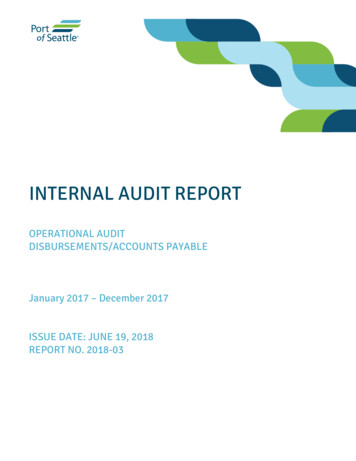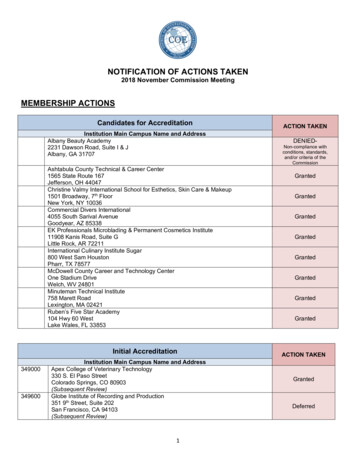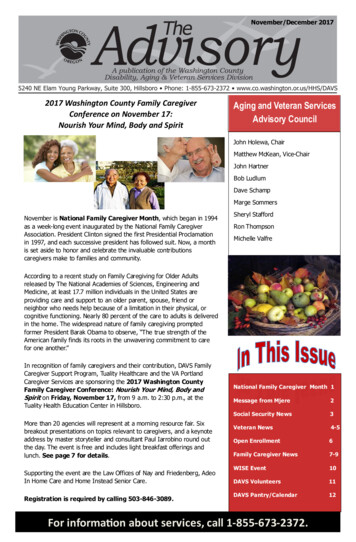Transcription
NOVEMBER 2018DisbursementsTracker NO SITTER?NO PROBLEM:HOW WYNDY IS USINGMOBILE TO CREATE AUsing mobile devices to make hiringbabysitters more convenient– Page 6 (Feature Story)Worldpay expands instant payout offering to50 countries– Page 10 (News and Trends)The top players in thedisbursements ecosystem– Page 21 (Provider Directory)MODERNHIRINGEXPERIENCEpowered by
Disbursements Tracker Table of Contents03WHAT’S INSIDE06FEATURE STORY10NEWS AND TRENDS14DEEP DIVE21104The newest disbursements developments, including the rise of real-time payment programs across the globeTommy Mayfield, CEO and founder of Wyndy, explains how mobile devices and integrated payments can make routinetasks, like hiring a babysitter, much easierThe latest headlines from around the space, including Worldpay’s effort to expand its instant payouts toolto 50 countriesPYMNTS explores how companies are utilizing instant payments to retain freelancers and gig workersPROVIDER DIRECTORYThe top companies in the disbursements market — including networks, enabling platforms and point solutions — basedon the services they provideABOUTInformation about PYMNTS.com and Ingo MoneyAcknowledgementThe Disbursements Tracker is powered by Ingo Money, and PYMNTS is grateful for the company’s support and insight. PYMNTS.com retains full editorial control over thefindings presented, as well as the methodology and data analysis. 2018 PYMNTS.com All Rights Reserved2
What’s InsideFaster payments are gaining more groundacross the United States. With the spaceexpected to be worth 255 billion by the endof 2018, the value and impact of faster payments isonly increasing. There are now 40 active real-timepayment programs globally — more than three timeswhat was available just four years ago.With the gig economy expanding and the reliance ononline services becoming inescapable, increasingthe speed of disbursements is of the essence,particularly as gig workers seek out faster payments,forcing businesses to confront new challenges.According the latest Gig Economy Index, PYMNTSresearchers found that 85 percent of gig workerswant to be paid faster and would take on more work ifthey were.To fit these changing needs, Worldpay is bringingits disbursement solutions to new areas — thecompany launched its instant payout feature in 50more countries this year. As with Worldpay, there is agrowing group of companies in the space working tobuild disbursement solutions and payment networksto support both the speed volume of money beingexchanged between businesses and consumers.Around the world of disbursementsFull-time employees also want to receive their moneyfaster, which may explain why payroll has becomeone of the top areas that companies are focusingon improving. In a recent survey, more than a thirdof B2B companies told researchers they want to usefaster payments in payroll, while 57 percent say theywant to use faster payments to improve accountspayable.To provide companies with those faster payments,the Clearing House now has 36 institutions linked toits Real-Time Payments (RTP) network, solidifyingthe importance of RTP for banks, businesses andconsumers.Real-time payment programs are becoming morepopular around the world, with five real-timepayments networks currently in development andanother 16 set to go live in the next 12 to 18 months.Europe is quickly enabling businesses’ access toreal-time payments with the help of providers likeACI Worldwide, which is helping banks and financialinstitutions (FIs) across the continent access thesenew connected payments schemes.The rise of real-time payments isn’t just a benefit foremployees. According to a recent report, 78 percentof merchants believe real-time payments will alsoimprove customer experiences.Even outside of a faster or real-time paymentsnetwork, a wide range of solution providers arelooking to move money faster. Mastercard, forinstance, is bringing real-time bill payment to themobile banking apps it supports.To read more on these stories and other headlinesfrom around the space, check out the Tracker’s Newsand Trends section (p. 10).Deep Dive: Visa, Postmates partner for instantpaymentsAs the gig economy continues to grow, so dogig workers’ demands for faster disbursements.Ridesharing services, like Uber and Lyft, areimplementing instant payment features, givingdrivers faster access to their money. Visa is alsogetting involved by partnering with delivery servicePostmates to make payments instant for their morethan 200,000 gig workers.In the Disbursements Tracker Deep Dive (p. 14),PYMNTS explores these and other recent gigpayment developments, as well as why such paymentmethods are gaining popularity with people who relyon gig and freelance work. 2018 PYMNTS.com All Rights Reserved3
What’s InsideUsing mobile devices to make hiring a babysittermore convenientFinding enough time in the day for everything on yourto-do list is tricky, especially for parents. Finding,hiring and paying a babysitter can be a dauntingtask, particularly when parents have to rely on wordof-mouth to find a trustworthy candidate. In thesmartphone era, however, new options are emergingthat allow parents to book, rate and pay sitters, all inone place.In the Disbursements Tracker feature story (p. 6),Wyndy founder and CEO Tommy Mayfield discussesthe need for such a platform in a world where onlineinteraction has become the norm, and how providingparents with a holistic payments and babysitterexperience can eliminate some of their dailystressors.November Tracker UpdatesEach month, the Tracker’s provider directoryhighlights leading disbursement players from aroundthe space. The latest edition boasts more than 100providers, including three new additions: MobilePay,Pingit and Swish.Executive InsightWhy are we seeing accelerated adoptionand growth in instant payments and whatshould we expect in the coming months?“The rate of adoption for instant payment solutionsis rapidly accelerating for two reasons. The first isconsumer and small business demand. These segmentsare conditioned by experiences in retail, travel andentertainment to expect instant, customer centered,customizable interactions in all aspects of their lives– including money. A recent PYMNTS study found that75.5% of U.S. consumers who received disbursementssay speed is important to them. For small businesses thatdepend on cash flow as a competitive advantage, thisnumber is even greater: 86% expect instant payments andthe majority are willing to pay a fee to receive them.The second reason why the rate of adoption for instantpayment solutions is rapidly accelerating is the inherentbusiness benefits. Just as small businesses needaccess to real-time disbursements to thrive, so too canpayors enhance their bottom lines. Those companiesthat offer instant payments – whether they're insurers,lenders, merchant processes, or others – can delighttheir customers and earn long-term loyalty. At the sametime, they can significantly cut costs compared to paperchecks or even ACH disbursements, and, in some cases,add new revenue-earning lines of business.Over the remainder of 2018 and into 2019, we are goingto see this adoption grow even faster and wider. As thisTracker notes, this expansion has now encompassedpayroll, an enormous industry with the potential forquick penetration through third-party processors andlarge providers. We have passed the tipping point andare well on our way to the true instant money economy.”Drew Edwards, CEO of Ingo Money 2018 PYMNTS.com All Rights Reserved4
5 FAST FACTSWhat’s Inside57%Portion of B2B payment technology companiesplanning to implement faster payment technologiesto their accounts payable departments 225B40Number of real-time paymentnetworks active worldwide61%78%Expected value of fasterpayments transactions made inthe U.S. this yearPortion of firms that believe implementing realtime payments would improve payroll operationsShare of firms that believe implementingreal-time payments would improvecustomer experiences 2018 PYMNTS.com All Rights Reserved5
No Sitter?No Problem:HOW WYNDY IS USING MOBILETO CREATE A MODERNHIRING EXPERIENCE 2018 PYMNTS.com All Rights Reserved6
Feature Story“why wasn’t there an app thatcould make it just as easy for meto get a trusted babysitter?Tommy Mayfield, founder and CEO, WyndyModern parents have to juggle multiple things atonce, which makes finding the right babysittermore of a challenge. Parents typically rely onfamily, friends or word of mouth to find sitters, hopingthat someone will be available on short notice or at anaffordable rate.Many other consumer services are just a smartphone tapaway, so it’s easy to see why parents get frustrated withthis old-fashioned experience. Tommy Mayfield, founderand CEO of childcare hiring platform Wyndy, is hoping tofill that gap in the market.Wyndy’s mobile platform moves this process into thedigital era, allowing parents to find a sitter who matchestheir criteria, whether that's availability, rating or evena specific college major. Sitters, after completing theapplication process and passing a background check, canuse the app to search for safe, reliable part-time work.The goal, Mayfield told PYMNTS in a recent interview, is tomodernize the process for hiring a sitter.“It occurred to us that we were living in this world wherewe had apps like Lyft where we could get a ride or getour groceries delivered [with] the tap of a button. [Wewondered,] why wasn’t there an app that could make itjust as easy for me to get a trusted babysitter?” he said.Serving parents and sitters alikeWyndy's website launched in January 2017, and thecompany officially opened for business in Mayfield'shometown of Birmingham, Alabama, that November. 2018 PYMNTS.com All Rights Reserved7”
Feature StoryWe tapped into a trusted segmentof the population: full-timecollege or graduate studentsIts app, which serves both parents and caregivers, isavailable on the App Store and Google Play in sevenmarkets in Southeastern United States.To join the service, users first build profiles on the app,filling in information about their babysitting experience,or the age of their children and their location. Both partiescan then use those profiles to post or search for jobs.For Wyndy to be successful, parents must feel confidentthat it can be trusted for childcare needs. Mayfieldexplained that the company builds that trust in three keyways, including how it chooses its sitters.“Before Wyndy, a trusted recommendation from a friendwas the most likely scenario where you’d get a newbabysitter,” Mayfield said. “We’ve sort of taken thatconcept and put technology on top of it.”Creating the mobile experienceMoving from a word-of-mouth experience to a mobileone is tricky, but necessary, as more consumers relyon their smartphones for their daily needs — especiallymillennials, more of whom are starting to have children.Wyndy’s app covers all facets of booking, from findinga sitter to payment. Sitters set an in-app timer for theduration of each job, and parents set their hourly rates.Stripe handles each transaction, meeting sitters’ desiresfor easier and faster payments and providing a servicethat parents will likely recognize from other apps, like Lyftor Shift.“Through our integration with Stripe, the sitters all set uptheir own Stripe account, so the money just flows throughStripe,” he said. “The portion that goes to us, goes to us.And the portion that goes to the sitter, goes to the sitter’saccount.”“We tapped into a trusted segment of the population: fulltime college or graduate students,” Mayfield said, addingthat each sitter goes through a background check andpersonal review before they’re accepted. “We’ve done thevetting process for parents.”The app helps parents engineer connections throughvarious features, including a social element that letsparents communicate and discuss sitters they’ve usedbefore. Parents can also see sitters’ ratings and howmany times they’ve been booked. 2018 PYMNTS.com All Rights Reserved8
Feature StoryWyndy takes a small service fee, which varies but isalways less than 10 percent, from each transaction.Modern consumers expect payment options from theirmobile apps, Mayfield noted, making the Stripe integrationnecessary.This combination of speed and convenience is a recurringtheme for modern payments experiences from companieslike Stripe and instant money company Ingo Money –they aid in product adoption, customer engagement, feesand more.“Today’s 20-year-olds expect that the world works with[mobile] marketplaces,” Mayfield said. “We’re now seeingthe benefit of that transition into the smartphone world,even on the parents’ side.”Mayfield noted the company will continue to monitormobile trends, especially as newer parents, including somewho were raised expecting all of their needs to be metthrough online and mobile services, come into the market.What comes nextIn the future, Mayfield said that the company plans tobuild out its team and expand. It recently closed a milliondollar seed round of funding, which will help it reach newmarkets and create new features.“Our long-term goal is to build that machine and hopefullyraise a larger round [and] try to replicate this in manymore markets,” Mayfield said. “There’s 15 billion a yearspent on babysitting, and about 97 percent of that is stillspent on the traditional, old-school, meet-random-peopleand-put-them-in-your phone [way].”Online and mobile services are increasingly becoming thenorm, and that 15 billion-a-year industry is no exception.Mayfield said the word-of-mouth nature of the businesswould likely soon give way to an online and mobile-drivenmarket, with or without Wyndy.“In five years, if it’s not Wyndy, it’s going to be something,”he said. “I think this is a trend that’s going to continue,and we’re excited to pursue it.”As parents, college students and general consumerscontinue their mobile migration, moving serviceslike babysitting to smartphones will be a key way forcompanies to keep up with shifting expectations. 2018 PYMNTS.com All Rights Reserved9
News and TrendsWhat’s new in real-time paymentsReal-time payment systems are multiplyingConsumers are demanding more immediate moneymovement, and global providers are responding.According to one recent report, the number of active realtime payment systems has tripled since 2014, and thatgrowth rate is increasing. There are now 40 active realtime payment systems around the world, up from 25 in2017. An additional 16 systems are expected to go live inthe next 12 to 18 months, according to research from FIS.Growth is particularly strong in the U.K., where merchantsare already adopting tools that allow customers touse real-time bank transfers to pay for goods andservices. This could have a significant impact on theway consumers approach payments in their daily lives,as these systems allow customers and businesses totransact faster. These systems gained rapid acceptancein the United Kingdom, and other regions are receptive tointegrating them.TCH aims to connect thousands of banks to its RTPnetworkThe Clearing House (TCH), based in New York City, mayhave finished the third quarter of 2018 with 36 financialinstitutions connected to its real-time payments network,RTP, but it’s aiming to have more than 1,000 institutionsconnected by the end of the next quarter. TCH is projectedto have approximately 7,000 institutions connected bythe end of next year, meaning that more than half ofthe demand deposit accounts in the U.S. will be able toreceive RTP transactions. It also means that just under40 percent of these accounts will be able to send realtime payments, according to Tim Mills, vice president ofbusiness development and product management for TCH.As a 165-year-old institution, TCH’s original role in thepayments ecosystem mostly surrounded check clearing.Now, the company is taking on ACH and expanding realtime payments to make the experience more ubiquitousfor all players involved.ACI Worldwide wants to power real-time paymentsacross EuropeReal-time payments capabilities are moving quicklyacross Europe with the help of electronic paymentsolution provider ACI Worldwide, which recently openedits real-time payments network to banks and paymentservice providers across Europe. The solution, known asthe pan-European Target Instant Payment Settlement (orTIPS) scheme, is slated to go live at the end of November2018.ACI is also working on a faster payments solution inthe Netherlands and Eastern Europe. The company alsosupported the U.K.’s Faster Payments scheme when 2018 PYMNTS.com All Rights Reserved10
News and Trendsit was launched in 2008. All told, faster payments arebecoming more ingrained in the European paymentecosystem.In a statement on the expansion of the solution, CraigRamsey, head of real-time payments for ACI Worldwide,said that the goal is to enter the European market withoutcausing a disruption for banks and FIs. “[Our solution] isdesigned for banks to get up and running fast, at minimalcost and with the ability to scale functionally and handleincreasing transaction volumes,” Ramsey said.How finance is responding to same-daySame-day payments already popular with treasurersThe use of same-day payment capabilities is steadilyincreasing — particularly among treasurers around theworld. The majority of treasury professionals (64 percent)are already using same-day payments or another paymentsolution that enables the same effect, according to astudy by Bottomline Technologies.In the U.S., Same Day ACH (which has recently updatedboth credit and debit payments to process same-day)is becoming one of the more popular payment rails forthe country’s businesses. One-third of U.S. businessessaid they’re either planning to, or already use Same DayACH, which suggests that the need for a system that canhandle more transactions at a faster rate is increasing notjust in the U.S., but globally. According to researchers, italso shows that businesses, institutions and consumersare expecting to be able to send and receive paymentswithin the same day, if not the same hour, which explainswhy many are exploring technologies like blockchain andfaster payment initiatives.Treasury banks are on the front end of this curve. In arecent interview with PYMNTS.com, Ingo Money CEODrew Edwards and KeyBank Head of Product & Innovationof Enterprise Commercial Payments Matt Miller bothcommented on the importance of the bank’s recentdeployment of real time disbursement solutions fortreasury customers. Miller went so far as to say that givingbusiness clients the ability to pay anyone in an instant andinto any account they choose will go a long way towardsdetermining the winners in the disbursement space.The Fed wants you to tell it how to makepayments fasterWhile faster payments for businesses and consumersspread around the world, the U.S. Federal Reserve isseeking suggestions on how it can keep up. Payments needto be as immediate as everything else in the smartphoneage, according to Fed governor Lael Brainard. Because U.S.payment systems are a bit “patchwork,” the Fed is openinga comment period for those who may have ideas on anypotential steps it can take to fix its system and support thevision of faster payments. Ingo Money’s Bill Zielke is oneperson that jumped into the fray with the suggestion that in 2018 PYMNTS.com All Rights Reserved11
News and Trendsaddition to speed, any Fed-led changes must also deliver onconvenience, choice and confidence. The Fed is currentlyexploring several options for real-time and faster payments.Most banks rely on solutions that allow them to processinternational payments as fast as possible, which makescutting through the snarls left behind by a complicatedlegacy infrastructure, like the networks in the U.S., allthe more important. Fixing these problems will becomeespecially crucial as the global economy becomes furtherinterconnected.Changing how gig workers get paidVisa partners with
task, particularly when parents have to rely on word-of-mouth to find a trustworthy candidate. In the smartphone era, however, new options are emerging that allow parents to book, rate and pay sitters, all in one place. In the











